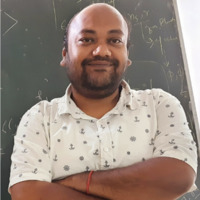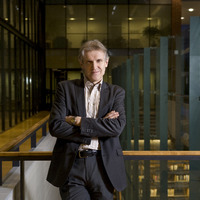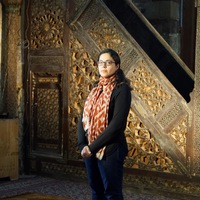
Sayantan Choudhury
I am a Theoretical Physicist who loves to work in various areas of Theoretical Physics. I do not have any prejudice to work in a particular area of research, if I love the idea then I always try to work on that.
Research Interests:
================
1. Theoretical Cosmology (Inflation and alternatives, Dark Matter, Dark Energy, Primordial Gravity Waves, Large Scale Structure),
2. Quantum Entanglement and Information Theory,
3. Quantum Dissipative System,
4. Open Quantum System,
5. Thermalization and Quantum Quench,
6. Out-of-Equilibrium Quantum Field Theory,
7. Effective field theory,
8. Random Matrix Theory,
9. Phenomenology from Warped Extra Dimensions,
10. Cosmological model building with Supergravity and String theory,
11. String Cosmology, Study of SYK and Tensor like models,
12. AdS/CFT and AdS/CMT,
13. Foundational aspects of Cosmological Out-of -Time-Ordered-Correlation (OTOC),
14. Quantum Chaos and Complexity,
15. Quantum Neural Network and Machine Learning.
Academic Credentials:
=================
B.Sc in Physics (Hons.), July 2007
Scottish Church College (University of Calcutta)
Kolkata, India.
M.Sc in Physics, July 2009
University of Calcutta, Kolkata, India.
Ph.D., Theoretical Physics (Cosmology), March 2016
Physics and Applied Mathematics Unit,
Indian Statistical Institute, Kolkata, India
(Degree obtained from University of Calcutta)
Thesis title: Field Theoretic Approaches to Early Universe
Advisor: Dr. Supratik Pal
Professional Training :
=================
Post-Doctoral Fellow,
February 2015 to October 2017
Department of Theoretical Physics,
Tata Institute of Fundamental Research (TIFR), Mumbai, India
Post-Doctoral Fellow,
October 2017 to March 2018
Inter-University Centre for Astronomy and Astrophysics
(IUCAA), Pune, India
Junior Scientist/Post-Doctoral Fellow,
March 2018 to October 2020
Quantum Gravity and Unified Theories and
Theoretical Cosmology Group,
Max Planck Institute for Gravitational Physics,
(Albert Einstein Institute),
Potsdam-Golm, Germany.
Jagadish Chandra Bose Visiting Scientist,
October 2020 to till date
School of Physical Sciences,
National Institute for Science Education and Research, Bhubaneswar
P.O. Jatni, Khurda 752050, Odisha, India.
Visiting Scientist, November 2021 to February 2022,
Institute of Physics, Bhubaneswar,
P.O. : Sainik School, Sachivalaya Marg, Gajapati Nagar, Bhubaneswar, Odisha 751005, India.
Visiting Scientist, Octoberber 2020 to February 2022,
Homi Bhabha National Institute (HBNI),
Training School Complex, Anushakti Nagar, Mumbai, Maharashtra 400094, India.
Visiting Post-Doctoral Fellow, March 2022 to August 2022,
International Centre for Theoretical Sciences (ICTS),
Tata Institute of Fundamental Research (TIFR), Bengaluru
Survey No. 151, Shivakote, Hesaraghatta, Uttarahalli Hobli, Bengaluru,560089, India.
Assistant Professor (Senior Grade), August 2022 to present,
The Thanu Padmanabhan Centre For Cosmology and Science Popularization (CCSP)
Shree Guru Gobind Singh Tricentenary (SGT) University, Gurugram, Delhi-NCR,
Gurugram-Badli Road, Budhera, Gurugram - 122505, India.
Link of publications:
================
https://inspirehep.net/authors/1074660
https://arxiv.org/search/?query=sayantan+choudhury&searchtype=all&source=header
https://scholar.google.com/citations?hl=en&user=iXXgf04AAAAJ
Supervisors: Prof. Shiraz Minwalla, Prof. Sudhakar Panda, Prof. Soumitra SenGupta, and Dr. Anupam Mazumdar
Phone: +917849044574
Address: INSTITUTE ADDRESS:
Dr. Sayantan Choudhury/डॉ. सायंतन चौधरी
Assistant Professor (Senior Grade)/सहायक प्रोफेसर (वरिष्ठ ग्रेड)
Member of The National Academy of Sciences, India (MNASc)/राष्ट्रीय विज्ञान अकादमी, भारत के सदस्य (एमएनएएससी)
The Thanu Padmanabhan Centre For Cosmology and Science Popularization (CCSP),
Shree Guru Gobind Singh Tricentenary (SGT) University, Gurugram, Delhi-NCR, Gurugram-Badli Road, Budhera, Gurugram - 122505, India/
थानु पद्मनाभन सेंटर फॉर कॉस्मोलॉजी एंड साइंस पॉपुलराइजेशन (सीसीएसपी),
श्री गुरु गोबिंद सिंह ट्राइसेंटेनरी (एसजीटी) विश्वविद्यालय, गुरुग्राम, दिल्ली-एनसीआर, गुरुग्राम-बादली रोड, बुढेरा, गुरुग्राम - 122505, भारत।
Contact Phone no/संपर्क फ़ोन नंबर:: +91 78490 44574, +91 8697365275
Email/ईमेल: sayantan_ccsp@sgtuniversity.org,
sayanphysicsisi@gmail.com
Homepage/मुखपृष्ठ: https://www.ccspsgt.science/sayantan-choudhury
Research Interests:
================
1. Theoretical Cosmology (Inflation and alternatives, Dark Matter, Dark Energy, Primordial Gravity Waves, Large Scale Structure),
2. Quantum Entanglement and Information Theory,
3. Quantum Dissipative System,
4. Open Quantum System,
5. Thermalization and Quantum Quench,
6. Out-of-Equilibrium Quantum Field Theory,
7. Effective field theory,
8. Random Matrix Theory,
9. Phenomenology from Warped Extra Dimensions,
10. Cosmological model building with Supergravity and String theory,
11. String Cosmology, Study of SYK and Tensor like models,
12. AdS/CFT and AdS/CMT,
13. Foundational aspects of Cosmological Out-of -Time-Ordered-Correlation (OTOC),
14. Quantum Chaos and Complexity,
15. Quantum Neural Network and Machine Learning.
Academic Credentials:
=================
B.Sc in Physics (Hons.), July 2007
Scottish Church College (University of Calcutta)
Kolkata, India.
M.Sc in Physics, July 2009
University of Calcutta, Kolkata, India.
Ph.D., Theoretical Physics (Cosmology), March 2016
Physics and Applied Mathematics Unit,
Indian Statistical Institute, Kolkata, India
(Degree obtained from University of Calcutta)
Thesis title: Field Theoretic Approaches to Early Universe
Advisor: Dr. Supratik Pal
Professional Training :
=================
Post-Doctoral Fellow,
February 2015 to October 2017
Department of Theoretical Physics,
Tata Institute of Fundamental Research (TIFR), Mumbai, India
Post-Doctoral Fellow,
October 2017 to March 2018
Inter-University Centre for Astronomy and Astrophysics
(IUCAA), Pune, India
Junior Scientist/Post-Doctoral Fellow,
March 2018 to October 2020
Quantum Gravity and Unified Theories and
Theoretical Cosmology Group,
Max Planck Institute for Gravitational Physics,
(Albert Einstein Institute),
Potsdam-Golm, Germany.
Jagadish Chandra Bose Visiting Scientist,
October 2020 to till date
School of Physical Sciences,
National Institute for Science Education and Research, Bhubaneswar
P.O. Jatni, Khurda 752050, Odisha, India.
Visiting Scientist, November 2021 to February 2022,
Institute of Physics, Bhubaneswar,
P.O. : Sainik School, Sachivalaya Marg, Gajapati Nagar, Bhubaneswar, Odisha 751005, India.
Visiting Scientist, Octoberber 2020 to February 2022,
Homi Bhabha National Institute (HBNI),
Training School Complex, Anushakti Nagar, Mumbai, Maharashtra 400094, India.
Visiting Post-Doctoral Fellow, March 2022 to August 2022,
International Centre for Theoretical Sciences (ICTS),
Tata Institute of Fundamental Research (TIFR), Bengaluru
Survey No. 151, Shivakote, Hesaraghatta, Uttarahalli Hobli, Bengaluru,560089, India.
Assistant Professor (Senior Grade), August 2022 to present,
The Thanu Padmanabhan Centre For Cosmology and Science Popularization (CCSP)
Shree Guru Gobind Singh Tricentenary (SGT) University, Gurugram, Delhi-NCR,
Gurugram-Badli Road, Budhera, Gurugram - 122505, India.
Link of publications:
================
https://inspirehep.net/authors/1074660
https://arxiv.org/search/?query=sayantan+choudhury&searchtype=all&source=header
https://scholar.google.com/citations?hl=en&user=iXXgf04AAAAJ
Supervisors: Prof. Shiraz Minwalla, Prof. Sudhakar Panda, Prof. Soumitra SenGupta, and Dr. Anupam Mazumdar
Phone: +917849044574
Address: INSTITUTE ADDRESS:
Dr. Sayantan Choudhury/डॉ. सायंतन चौधरी
Assistant Professor (Senior Grade)/सहायक प्रोफेसर (वरिष्ठ ग्रेड)
Member of The National Academy of Sciences, India (MNASc)/राष्ट्रीय विज्ञान अकादमी, भारत के सदस्य (एमएनएएससी)
The Thanu Padmanabhan Centre For Cosmology and Science Popularization (CCSP),
Shree Guru Gobind Singh Tricentenary (SGT) University, Gurugram, Delhi-NCR, Gurugram-Badli Road, Budhera, Gurugram - 122505, India/
थानु पद्मनाभन सेंटर फॉर कॉस्मोलॉजी एंड साइंस पॉपुलराइजेशन (सीसीएसपी),
श्री गुरु गोबिंद सिंह ट्राइसेंटेनरी (एसजीटी) विश्वविद्यालय, गुरुग्राम, दिल्ली-एनसीआर, गुरुग्राम-बादली रोड, बुढेरा, गुरुग्राम - 122505, भारत।
Contact Phone no/संपर्क फ़ोन नंबर:: +91 78490 44574, +91 8697365275
Email/ईमेल: sayantan_ccsp@sgtuniversity.org,
sayanphysicsisi@gmail.com
Homepage/मुखपृष्ठ: https://www.ccspsgt.science/sayantan-choudhury
less
Related Authors
Arnab Kundu
Saha Institute of Nuclear Physics
Antal Jevicki
Brown University
Matti Vartiainen
Aalto University
Michael Ridley
Bar-Ilan University
Andrew K Mitchell
University College Dublin
Omniya Abdel Barr
Victoria and Albert Museum
InterestsView All (51)








Uploads
Papers by Sayantan Choudhury
∞
algebra that represents the gCC state after a quench in de Sitter space and found it to be significantly different from the flat space-time results. We extend our study for the different two-point correlation functions not only considering the pre-quench state as the ground state, but also a squeezed state. We found that irrespective of the pre-quench state, the post quench state can be written in terms of the gCC state showing that the subsystem of our interest thermalizes in de Sitter space. Furthermore, we provide a general expression for the two-point correlators and explicitly show the thermalization process by considering a thermal Generalized Gibbs ensemble (GGE). Finally, from the equal time momentum dependent counterpart of the obtained results for the two-point correlators, we have studied the hidden features of the power spectra and studied its consequences for different choices of the quantum initial conditions.
∞
algebra that represents the gCC state after a quench in de Sitter space and found it to be significantly different from the flat space-time results. We extend our study for the different two-point correlation functions not only considering the pre-quench state as the ground state, but also a squeezed state. We found that irrespective of the pre-quench state, the post quench state can be written in terms of the gCC state showing that the subsystem of our interest thermalizes in de Sitter space. Furthermore, we provide a general expression for the two-point correlators and explicitly show the thermalization process by considering a thermal Generalized Gibbs ensemble (GGE). Finally, from the equal time momentum dependent counterpart of the obtained results for the two-point correlators, we have studied the hidden features of the power spectra and studied its consequences for different choices of the quantum initial conditions.
between the conduction phenomena in electrical wires with impurity and the
scattering events responsible for particle production during stochastic
inflation and reheating implemented under a closed quantum mechanical
system in early universe cosmology. In this connection, we also present a
derivation of quantum corrected version of the Fokker Planck equation
without dissipation and its fourth-order corrected analytical solution for
the probability distribution profile responsible for studying the dynamical
features of the particle creation events in the stochastic inflation and
reheating stage of the universe. It is explicitly shown from our
computation that quantum corrected Fokker Planck equation describes the
particle creation phenomena better for Dirac delta type of scatterer. In
this connection, we additionally discuss Ito, Stratonovich prescription and
the explicit role of finite temperature effective potential for solving the
probability distribution profile. Furthermore, we extend our discussion of
particle production phenomena to describe the quantum description of
randomness involved in the dynamics. We also present computation to derive
the expression for the measure of the stochastic nonlinearity (randomness
or chaos) arising in the stochastic inflation and reheating epoch of the
universe, often described by Lyapunov Exponent. Apart from that, we
quantify the quantum chaos arising in a closed system by a more strong
measure, commonly known as Spectral Form Factor using the principles of
random matrix theory (RMT). Finally, we discuss the role of out of time
order correlation function (OTOC) to describe quantum chaos in early
universe cosmology.
between the conduction phenomena in electrical wires with impurity and the
scattering events responsible for particle production during stochastic
inflation and reheating implemented under a closed quantum mechanical
system in early universe cosmology. In this connection, we also present a
derivation of quantum corrected version of the Fokker Planck equation
without dissipation and its fourth-order corrected analytical solution for
the probability distribution profile responsible for studying the dynamical
features of the particle creation events in the stochastic inflation and
reheating stage of the universe. It is explicitly shown from our
computation that quantum corrected Fokker Planck equation describes the
particle creation phenomena better for Dirac delta type of scatterer. In
this connection, we additionally discuss Ito, Stratonovich prescription and
the explicit role of finite temperature effective potential for solving the
probability distribution profile. Furthermore, we extend our discussion of
particle production phenomena to describe the quantum description of
randomness involved in the dynamics. We also present computation to derive
the expression for the measure of the stochastic nonlinearity (randomness
or chaos) arising in the stochastic inflation and reheating epoch of the
universe, often described by Lyapunov Exponent. Apart from that, we
quantify the quantum chaos arising in a closed system by a more strong
measure, commonly known as Spectral Form Factor using the principles of
random matrix theory (RMT). Finally, we discuss the role of out of time
order correlation function (OTOC) to describe quantum chaos in early
universe cosmology.
We start our discussion with exploring the possibility of
MSSM inflation in the light of recent observed data from various D -flat directions using the saddle and inflection point techniques. The effective inflaton potential around saddle point and inflection point have been utilized in estimating the observable parameters and confronting them with WMAP7 and Planck dataset.
Next we explore the possibility of inflation from the five dimensional ${\cal N}=2$ supergravity setup by deriving the effective potential in the context of Randall-Sundrum like braneworld model and Dirac Bonn Infeld Galileon. After deriving an four dimensional effective potential, we obtain the inflationary observables from both the scenarios and confront them with the WMAP7 data. Further we fit the CMB angular power spectra from TT anisotropy and other polarization data obtained from WMAP7.
Further, we discuss the non-trivial features of reheating from supergravity inspired braneworld model, where the results are to some extent different from that of the usual low energy General Relativistic counterpart, because of the modified Friedmann equations in this setup. We explicitly derive the analytical expressions for the reheating temperature and further solve the evolution equation of the number density of thermal gravitino which results in the gravitino abundance.
Finally, we study the primordial non-Gaussian features using $\delta N$ formalism of unavoidable higher dimensional non-renormalizable K\"ahler operators for ${\cal N}=1$ supergravity framework.In particular we study the nonlinear evolution of cosmological perturbations on large scales which enable us to compute the curvature perturbation, without solving the exact perturbed field equations.Hence we compute the various non-Gaussian parameters for local type of non-Gaussianities,
for a generic class of sub-Planckian models dominated by the Hubble-induced corrections.